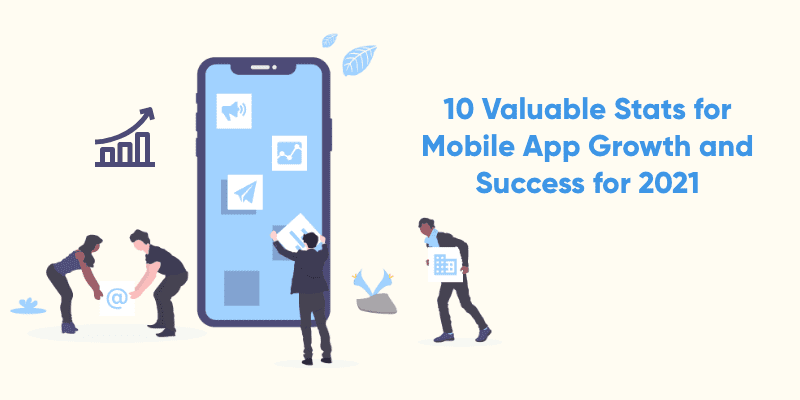Mobile App Statistics 2025: Growth, Revenue & User Behavior Trends in the USA
The mobile app industry in 2025 continues its explosive growth, driven by innovations in AI integration, 5G expansion, and increased demand for hyper-personalized user experiences. Whether you’re building an Android app, scaling an iOS platform, or targeting hybrid mobile solutions, understanding the latest mobile app usage statistics is essential to thrive in today’s competitive market. From B2B SaaS apps to B2C lifestyle and gaming apps, mobile continues to dominate digital engagement and revenue generation.
Mobile App Market Overview in 2025
In 2025, the global mobile app market is projected to exceed $935 billion in revenue, with the U.S. being a leading contributor. Android apps hold a market share of approximately 71%, while iOS apps dominate in monetization, generating higher revenue per user. Mobile-first behavior has become the norm, with 90% of smartphone time now spent within apps.
Key 2025 USA-Based Insights:
Over 7.5 million apps are available across Google Play and the App Store combined.
Daily mobile usage in the U.S. averages 5.1 hours per user.
Mobile gaming apps account for nearly 48% of total app revenue.
Finance, health, and productivity apps see the highest year-over-year download growth.
App Download & Usage Statistics
With over 258 billion app downloads expected globally in 2025, mobile app consumption continues to rise steadily. The U.S. ranks among the top three countries for both download volume and consumer spending.
Top downloaded categories: Social media, video streaming, fitness, finance.
Time spent per category:
Social & messaging apps: ~35%
Streaming & OTT apps: ~22%
Mobile games: ~20%
Retention rates: The average 30-day retention rate across all apps is 23%, emphasizing the need for intuitive UX and push notification strategies.
Mobile App Revenue in 2025
Monetization strategies have evolved significantly. Subscription-based models, in-app purchases, and ad-driven revenue streams dominate the mobile app economy.
Total global revenue: $935B+ (estimated)
Top-grossing sectors:
Mobile gaming
Health & fitness apps
Fintech & investment platforms
iOS users continue to spend 2x more on apps than Android users.
Trending Technologies Shaping Mobile Apps
In 2025, successful apps are powered by intelligent technologies. AI-driven features, voice interfaces, and blockchain-backed security are now key to user retention and trust.
Hot Trends:
AI Agents & Chatbots integrated in Android & iOS apps
Augmented Reality (AR) in retail and edtech apps
Edge computing to support faster, offline-first mobile experiences
No-code/low-code development tools reducing time-to-market
Cross-platform frameworks like Flutter & React Native still growing
Enterprise & B2B Mobile App Growth
B2B mobile applications are seeing unprecedented adoption, with enterprise clients investing in workflow automation, analytics, and remote team collaboration tools. The rise of custom mobile app development for logistics, construction, healthcare, and field services reflects a growing need for scalable, secure, and mobile-first software.
82% of businesses use mobile apps for internal operations in 2025.
Average enterprise app lifecycle is 3.7 years, showing long-term value.
Security and compliance remain top priorities, especially for U.S.-based apps handling customer data.
Future of Mobile Apps in 2025 and Beyond
As Gen Z and Gen Alpha drive demand for personalized, immersive, and secure mobile experiences, businesses must invest in mobile UX design, cross-device optimization, and cloud-native app architecture. With the integration of AI, blockchain, and decentralized identity systems, the mobile app industry is poised for continued disruption.
If you’re considering developing your own Android or iOS app in 2025, now is the time to invest in high-performing mobile strategies tailored for the U.S. market.
Final Thoughts
From gaming and finance to enterprise and health apps, the mobile app industry in 2025 is more dynamic than ever. With billions of downloads, evolving monetization models, and a mobile-first user base, businesses must keep pace with trends, technologies, and user expectations. By staying informed with the latest mobile app statistics, you can design, build, and market apps that stand out and deliver results—whether you’re targeting Android users, iOS audiences, or cross-platform ecosystems.
App statistics are playing a major role in evaluating the mobile app market. In this article, we’ll discuss all 10 valuable stats for mobile app growth.
Mobile apps have established their place well in many people’s lives. They have changed the way we communicate, work, and manage many things. We use them for almost everything we do; from mundane social media updates to professional, business-related affairs.
There are things that app developers should be concerned about these days. It is how to make mobile apps more presentable, catchy, user-friendly, and most importantly, how they can cater to this generation’s growing wants and needs.
So what’s in store for mobile apps in the years to come? Here are the 10 valuable app statistics that will influence mobile application development in 2023.
1. App Statistics On Growth in the Number of Mobile Users Worldwide
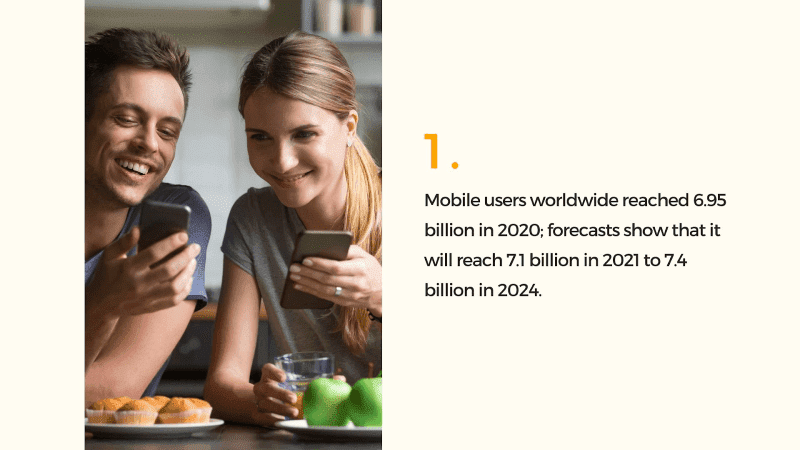
Mobile users worldwide reached 6.95 billion in 2021; forecasts show that it will reach 7.1 billion in 2021 to 7.4 billion in 2024.
Takeaway: As the number of mobile users grows worldwide, there will also be growth in the number of mobile apps deployed to cater to the needs of these large numbers of new mobile users.
2. Increase in Number of Mobile Applications
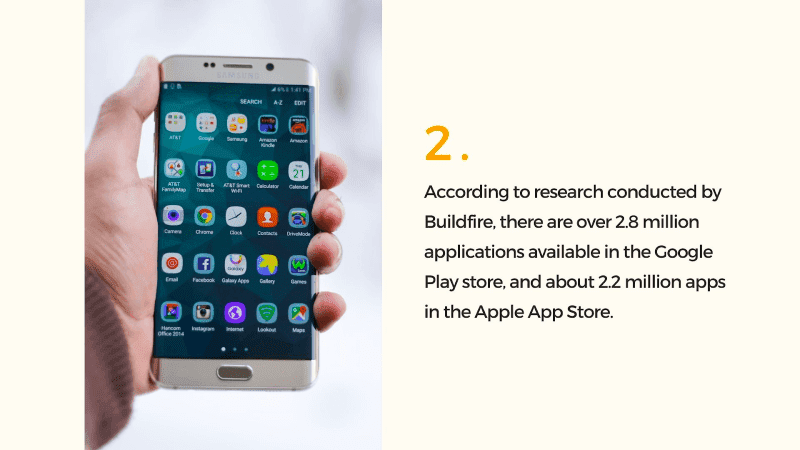
According to research conducted by Buildfire, there are over 2.8 million applications available in the Google Play store, and about 2.2 million apps in the Apple App Store. This shows us that users prefer Android apps over iOS that can be assumed that this is also due to the accessibility of the Google Play store.
As Android is also an open-source platform, application development is more diverse compared to iOS applications. Therefore, it is more flexible and customization is better.
Takeaway: Applications that are compatible with both Android and iOS are ideal, but it is good to leverage Android’s open-source platform and develop applications that can cater to the needs of more users.
3. App Statistics On Total of Global Mobile Advertising Expenditures

Advertising is one of the important means to promote and establish your brand in the market. It attempts to influence customers’ buying behavior and persuade them to buy products and/or employ services.
It is not surprising that many marketers use this strategy and according to research, mobile advertising expenditures will reach up to $240 billion by 2021 globally.
Takeaway: There are a lot of free applications that gain revenue by selling space for ads. This is an opportunity to buy ad spaces from popular, free applications. At the same time, this is also a good time to sell ad spaces and earn if you have a mobile application.
4. Frequency of Mobile Internet Access

Advertising is one of the important means to promote and establish your brand in the market. It attempts to influence customers’ buying behavior and persuade them to buy products and/or employ services.
It is not surprising that many marketers use this strategy and according to research, mobile advertising expenditures will reach up to $240 billion by 2021 globally.
Takeaway: There are a lot of free applications that gain revenue by selling space for ads. This is an opportunity to buy ad spaces from popular, free applications. At the same time, this is also a good time to sell ad spaces and earn if you have a mobile application.
5. Use of Mobile for Purchase
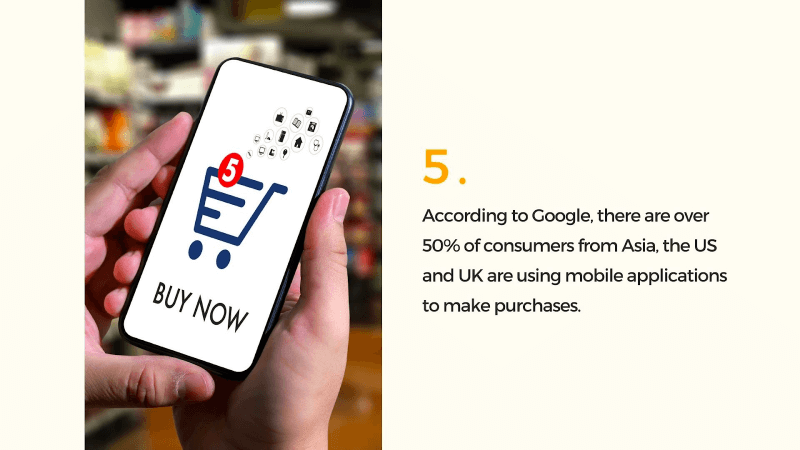
According to Google, there are over 50% of consumers from Asia, the US, and UK are using mobile applications to make purchases.
Online shopping avoids long lines and the hustle and bustle of shopping. Mobile apps for shopping create a good, and efficient way on how to make purchases without having to visit a store physically. With this, it is good to aim for a good customer experience on mobile apps.
Takeaway: Mobile eCommerce apps are good software to develop and invest with. Aside from that, technologies like Sephora’s Virtual Artist and Wanna Kicks are good applications to develop since AI will dominate the marketing trade in the near future. A valuable stats for mobile app growth you can’t ignore.
6. Increase in No. of Mobile Gamers
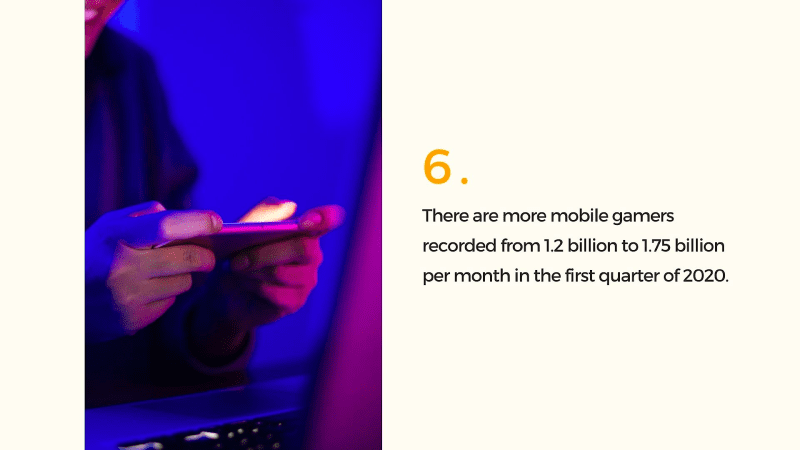
Due to COVID-19, there are more mobile gamers recorded from 1.2 billion to 1.75 billion per month in the first quarter of 2021.
Not only did the number of gamers increase, but the amount of playtime increased as well. The pandemic has halted a lot of activities for everyone, which includes leisure and entertainment. With nothing to do, there’s more time to play for everyone.
Takeaway: Mobile gaming industries have huge potential in the years to come. Games that allow engagement and communication with other players are on-trend. With this also comes challenges for game developers to look for new strategies and gameplays to provide new experiences to players worldwide.
7. Preferences on Free vs. Paid Apps
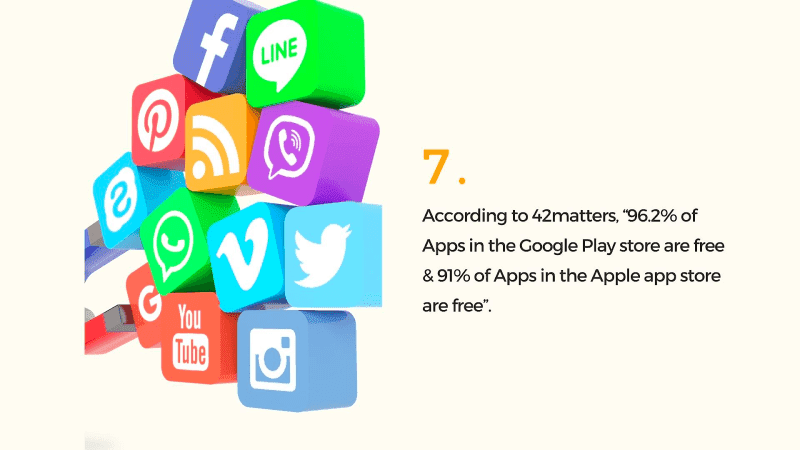
The main difference between paid apps and free apps is that paid apps are paid for by customers, and free apps are paid for by groups and companies in the form of ads. Companies, unlike app users, are more willing to spend on ads on an app. Users prefer to download free apps, preferring to spend on apps.
According to 42matters, “96.2% of Apps in the Google Play store are free & 91% of Apps in the Apple app store are free”. This is an important valuable stats for mobile app growth
Takeaway: Deciding on how to bring in revenue through mobile applications might be difficult at first but it depends entirely on how you want your app to be recognized.
8. It’s a full market
App Statistics show that most Android and iOS apps are free, which is 95% and 90% respectively. According to other sources, mobile applications will come up with $189 billion by 2021.
Monetizing plans like in-app purchases make for profits although the app was downloaded for free. For your app to be successful, it needs to be downloaded. As long as users have the app, it will continue to generate money.
Takeaway: Mobile application monetization is critical to the success of your app. You need to develop a good strategy that satisfies both you and your users.
9. Money matters a lot
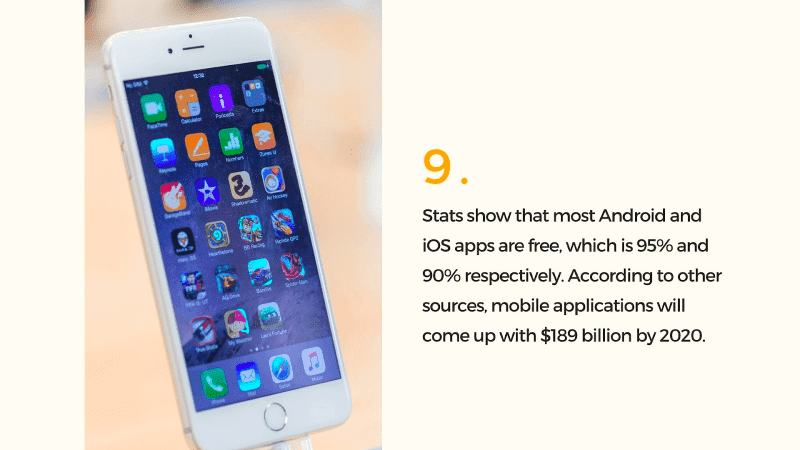
App Statistics show that most Android and iOS apps are free, which is 95% and 90% respectively. According to other sources, mobile applications will come up with $189 billion by 2021.
Monetizing plans like in-app purchases make for profits although the app was downloaded for free. For your app to be successful, it needs to be downloaded. As long as users have the app, it will continue to generate money.
Takeaway: Mobile application monetization is critical to the success of your app. You need to develop a good strategy that satisfies both you and your users.
10. Design and Performance Matters
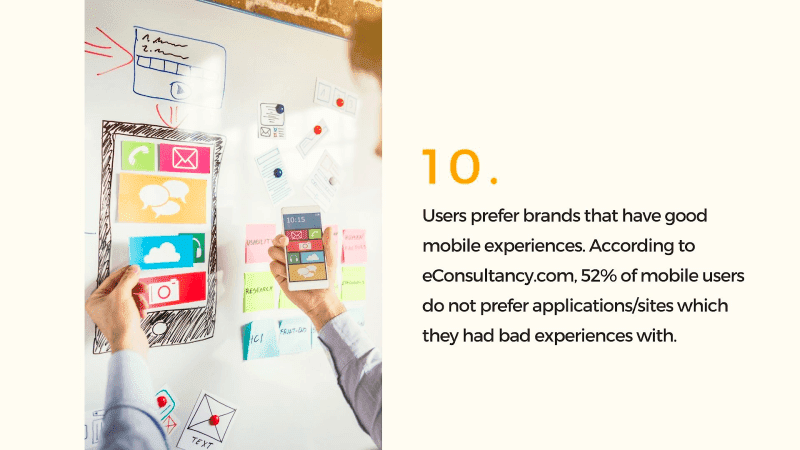
Users prefer brands that have good mobile experiences. According to eConsultancy.com, 52% of mobile users do not prefer applications/sites with which they had bad experiences.
Application performance is more crucial than its design. Customers and prospects will continuously use an app if only it proves to be adequate, practical, and performs well. Speed is also a huge factor considered by users, and slow-loading web pages as mobile applications are more likely to not be visited and downloaded again.
Takeaway: Mobile app development should consider improving UX(User Experience) and UI(User Interface). It is preferable to focus also on predictive analytics and AI to continuously improve processes and services.
Conclusion
It’s been said, again and again, numbers don’t lie. They show us the things we need to know about what to do and how to do it. The report on valuable stats for mobile app growth shows us the market that we have to look into to know what we’re dealing with.
The world of app development and the success it comes with is constantly shifting, always growing. It’s important to run tests and studies with the numbers they generate. This helps to fully understand where to invest, how to invest, and most importantly, why should we invest in this particular field.
